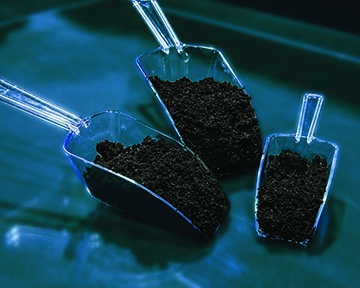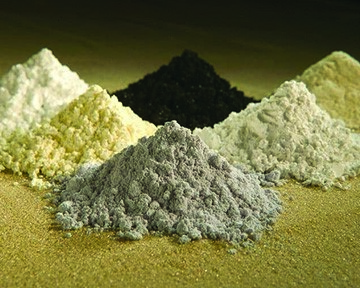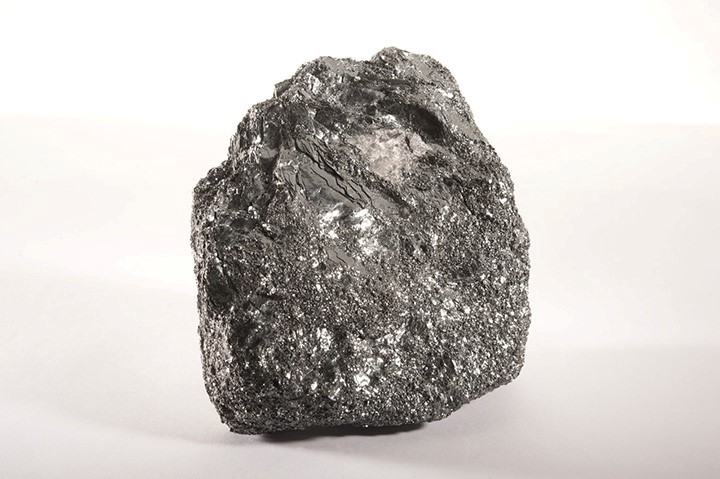Showing, Anomalous and Significant Thresholds for Metallic Substances in the SIGÉOM
Table of Showing, Anomalous and Significant Thresholds
Showing Thresholds
Showing thresholds for were defined in the past to indicate whether one of these substances was of economic interest. In 2023, due to the growing interest in critical and strategic minerals, showing thresholds were added for other elements such as Bi, Cd, Cs, Ga, In and Te. You can find out more about these various minerals on the Mineral Substances Portal.
A rock analysis for a given element with a content greater than or equal to the showing threshold is used to create a mineralized zone record in the SIGÉOM database. A mineralized zone is defined by one or more main substances that meet this criterion. The first main substance determines the zone symbol colour (French) on the interactive map. A mineralized zone may also include one or more secondary substances with contents below the showing value thresholds.
A content considered to be of “economic interest” for a given element, a concept more or less equivalent to a showing threshold, may change over time depending on the market. However, for reasons of consistency, SIGÉOM’s showing thresholds have remained unchanged since their creation. One of the only exceptions is silver, where the threshold has been raised from 5 to 50 ppm in 2023. The 5 ppm threshold was considered too low, which led to the creation of numerous mineralized zone records for geological contexts that were sometimes of little interest. However, silver mineralized zones created before 2023 with a threshold of 5 ppm have not been deleted from the SIGÉOM database. They are still visible on the interactive map by selecting the “Silver (Ag)” layer under the “Metallic substances” theme. It is also possible to access these records via “SIGÉOM à la carte”.
Moreover, prior to 2023, the showing thresholds for gold, copper, molybdenum, lead and zinc were different in the northern and southern parts of Québec. The threshold value was higher in the north of the province than in the south (Grenville, St. Lawrence Platform and Appalachian areas). This difference was explained in particular by better-developed infrastructure in the southern part of Québec, which justified exploration for lower-grade mineralization.
As of 2023, the showing thresholds were standardized across Québec and only the thresholds defined for the north of the province will now be used to create mineralized zone records in SIGÉOM. As in the case of silver, mineralized zone records created using the old thresholds have not been deleted and remain visible and accessible in SIGÉOM.
Some special cases:

Analyses for all are rare. In order to compare the mineralized zones with each other, it was decided to calculate the PGE contents by adding only the analytical results for platinum (Pt) and palladium (Pd), which are more commonly analyzed.

Since there is a showing threshold for yttrium (Y) and scandium (Sc), the rare earth elements (REE) are calculated solely by summing the analytical results for the lanthanides (elements 57 to 71 of the periodic table).

To create an iron mineralized zone, a showing content of 300 000 ppm Fe (30% Fe) is not enough. The iron must also be in the form of oxides (not sulphides or silicates). The thickness of the iron oxide layer must also be greater than one metre.
Anomalous and Significant Value Thresholds
These thresholds allow analyses with interesting contents to be targeted quickly. For example, a 0.4 g/t gold content in a sample represents an anomalous value and could be of interest to an exploration company.
Anomalous and significant thresholds were defined on the basis of statistical processing of SIGÉOM’s geochemical database, which totalled 338 089 analyses as of June 2017. No distinction was made as to the origin of the data or the analytical method.
Anomalous and significant thresholds were calculated for the following elements: Ag, Au, Be, Bi, Cd, Co, Cr, Cs, Cu, EGP, Fe, Ga, In, Li, Mn, Mo, Nb, Ni, Pb, Pd, Pt, REE, Rh, Sb, Sc, Sn, Ta, Te, Th, Ti, U, V, W, Y, Zn and Zr.
Anomalous Value Thresholds
The 95th percentile was calculated for each of the above elements from the SIGÉOM database. According to this criterion, 95% of the analyses are below this value and 5% above. Statistically reliable results were obtained for the following elements: Au, Cr, Cu, Fe, PGE,, REE and Rh. For the other elements, the cut-off values chosen represent a percentage of the showing thresholds:
- 30% of the showing threshold: Ag, Be, Bi, Cd, Co, Cs, Ga, In, Li, Mn, Mo, Nb, Pb, Pd, Pt, Sb, Sn, Ta, Te, Y, Zn and Zr;
- 50% of the showing threshold: Th, V and W;
- 75% of the showing threshold: Sc, Ti and U.
Significant Value Thresholds
This threshold corresponds to a content that is statistically different from the entire geochemical database as of June 2017, but does not exceed the anomalous value threshold. A value corresponding to one standard deviation of the normal distribution, i.e., the 84th percentile, was calculated. The rounded results are considered appropriate for all elements, with the exception of beryllium, for which a cut-off content equivalent to 10 times the detection limit was preferred, and uranium, for which a cut-off at 10% of the anomalous threshold was considered more appropriate.

